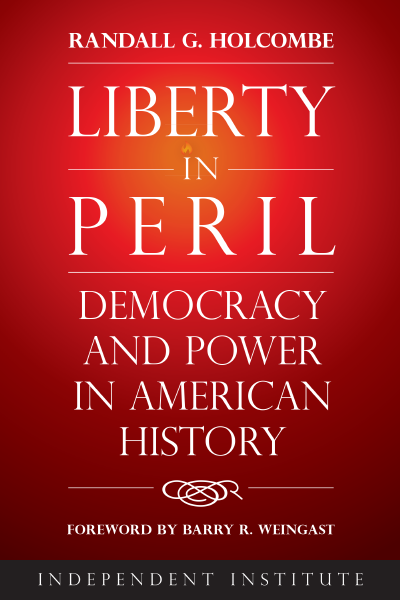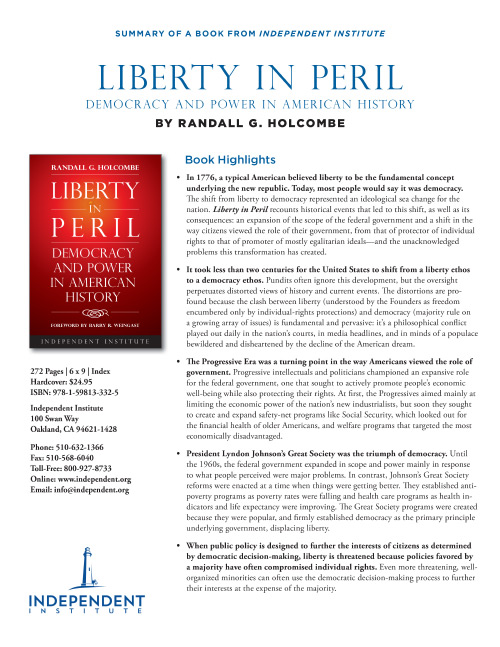Highlights
- In 1776, a typical American believed liberty to be the fundamental concept underlying the new republic. Today, most people would say it was democracy. The shift from liberty to democracy represented an ideological sea change for the nation. Liberty in Peril recounts historical events that led to this shift, as well as its consequences: an expansion of the scope of the federal government and a shift in the way citizens viewed the role of their government, from that of protector of individual rights to that of promoter of mostly egalitarian ideals—and the unacknowledged problems this transformation has created.
- It took less than two centuries for the United States to shift from a liberty ethos to a democracy ethos. Pundits often ignore this development, but the oversight perpetuates distorted views of history and current events. The distortions are profound because the clash between liberty (understood by the Founders as freedom encumbered only by individual-rights protections) and democracy (majority rule on a growing array of issues) is fundamental and pervasive: it’s a philosophical conflict played out daily in the nation’s courts, in media headlines, and in minds of a populace bewildered and disheartened by the decline of the American dream.
- The Progressive Era was a turning point in the way Americans viewed the role of government. Progressive intellectuals and politicians championed an expansive role for the federal government, one that sought to actively promote people’s economic well-being while also protecting their rights. At first, the Progressives aimed mainly at limiting the economic power of the nation’s new industrialists, but soon they sought to create and expand safety-net programs like Social Security, which looked out for the financial health of older Americans, and welfare programs that targeted the most economically disadvantaged.
- President Lyndon Johnson’s Great Society was the triumph of democracy. Until the 1960s, the federal government expanded in scope and power mainly in response to what people perceived were major problems. In contrast, Johnson’s Great Society reforms were enacted at a time when things were getting better. They established anti-poverty programs as poverty rates were falling and health care programs as health indicators and life expectancy were improving. The Great Society programs were created because they were popular, and firmly established democracy as the primary principle underlying government, displacing liberty.
- When public policy is designed to further the interests of citizens as determined by democratic decision-making, liberty is threatened because policies favored by a majority have often compromised individual rights. Even more threatening, well-organized minorities can often use the democratic decision-making process to further their interests at the expense of the majority.
Synopsis
The United States of America was, as Lincoln famously said, “conceived in liberty,” but in less than two centuries a different lodestar became fixed in the cultural firmament: the principle of democracy. The move from Liberty to Democracy was a seismic shift in the political landscape, with profound implications for virtually every area of public life. In Liberty in Peril: Democracy and Power in American History, public choice economist Randall G. Holcombe tells the story of this remarkable transformation—and the often-ignored threat it poses to individual rights and the constitutional ethos that seeks to limit the immense power wielded by governments.
Both a deep analysis of the nation’s changing norms and institutions and a wake-up call for the American people to rekindle the flame of liberty before it’s fully extinguished, Liberty in Peril provides the badly needed intellectual firepower to halt the juggernaut, restore the primacy of individual rights, and, as the preamble to the Constitution promises, “secure the blessings of liberty.”
The Principle of Liberty
Holcombe begins by discussing the sweeping intellectual and philosophical changes in Anglo-American thought that culminated in the American Revolution. Prior to the Founding Era, people viewed themselves as subjects of their governments and saw it as their duty to carry out the mandates of their rulers. The political ideas of the Enlightenment challenged this view, Holcombe explains. The British philosopher John Locke (1632-1704) laid the groundwork, arguing that individuals naturally possess rights and that the role of government is to protect those rights. If government did not fulfill its role, citizens have the right to replace it. These radical ideas were further popularized by Cato’s Letters in the 1720s and widely reprinted.
Although the American colonies were marked by regional differences and lingering loyalties, the new ideas about rights and government eventually united the colonies to secure the liberty of their citizens from the usurpations of King George III. The Declaration of Independence is primarily a list of grievances against the king, enumerating the ways he had violated the rights of the colonists. Yet woven into this indictment is a philosophical manifesto. It’s key principle—that people have the right to declare their independence and to create a new government when their rights are systematically usurped—makes the Declaration a major landmark in Western political thought.
Consensus vs. Democracy
The budding nation embraced liberty, consensus building, and representative government “for and by the people,” but not democracy per se. The Articles of Confederation (1781-1789) enabled the states to coordinate their efforts to break away from Britain, but questions arose about the role of the federal government after independence was secured. Some former colonists called for retrenchment, whereas others called for new federal powers such as the ability to raise revenue directly, without having to rely on the states. The convention called in 1787 was supposed to amend the Articles of Confederation, but it resulted in the completely new Constitution of the United States of America and a more powerful federal government, one less constrained by the states. This marked a major shift away from the principle of consensus in governance, toward the ideology of democracy.
Popular Opinion and Public Policy
The Constitution designed a government justly celebrated for its system of checks and balances, in which the three branches of government would hold each other to account and thereby curb abuses of power. For this to work, the executive branch, the judiciary, and the legislature must have roughly equal power. By deliberate design, the federal government was created to have little direct accountability to its citizens. Only half of the legislature, the House of Representatives, was to be directly chosen by citizen vote.
Senators originally were chosen by their state legislatures to represent the interests of their states. For national legislation to pass Congress, therefore, it had to meet the approval of both the representatives of the people, in the House, and the representatives of the state governments, in the Senate. This changed in 1913 with ratification of the 17th Amendment, which enabled citizens to directly elect Senators from their state and made the nation become more democratic.
Members of the judicial branch have always been appointed by the president and confirmed by the Senate, with no limit on their terms once appointed. These provisions insulated federal judges from democratic pressures. The president was to be chosen by an electoral college and the House of Representatives, insulating the chief executive from democratic pressures. The process for electing the president never worked as the Founders intended.
Electors from each state were to cast votes for presidential candidates. The Framers hoped this provision would ensure that most electors would vote for favorite son candidates from their states (thus, the requirement that electors vote for two candidates, at least one of whom was from a different state). The Framers believed that in most elections no candidate would get votes from a majority of electors, in which case the top five electoral vote recipients (amended to the top three in the 12th Amendment) would be sent to the House of Representatives. Thus, the electoral college was to act as a search committee, with members more knowledgeable than the general public, and the House would choose the president from among the top candidates. The Constitution, however, has never specified how states were to choose their electors, and the states rapidly moved toward popular voting for electors, creating the system that remains in place today.
Federal Growth and Democratic Accountability
The culture’s shift from a liberty-oriented ethos to a democratic one has been often gradual but sometimes punctuated by major
upheavals. The move toward popular voting for presidential electors was one step in the process. Andrew Jackson’s election to the presidency. The first president elected as a member of the Democratic party, but Jackson was also a democrat in the ideological sense, holding that the government should be checked by greater oversight from its citizens. The War Between the States gave the federal government considerably more power, partly because the scope of government increased as a result of the war, but even more because it established federal power over the state governments. The federal government, originally established as a federation of states, effectively became a national government.
In the first half of the twentieth century, two World Wars and the Great Depression further increased the scope of government, and the ideology of Progressivism increasingly oriented the government toward responding to democratic pressures. Those pressures in the first half of the twentieth century focused mainly on addressing the challenges of war and the economic hardship of depression. The popular idea that the government should do something to address those issues conveyed more power to the government, even as it threatened to compromise liberty.
The Progressive Challenge to Liberty
The ideology of Progressivism champions an expanded role for the state, with government looking out for people’s economic well-being as well as protecting their traditional rights. Progressivism gained popularity in the late 1800s, largely in response to the rise of economic power wielded by industrialists and financiers such as Rockefeller, Vanderbilt, Carnegie, and Morgan. Progressives wanted government to restrain the use of economic power to prevent the so-called “robber barons” from taking advantage of those with less economic power.
Progressivism wa s inherently redistributive from the start. It legitimized the use of government coercion to impose costs on some for the benefit of others. Originally, those who would bear the costs were people with concentrated economic power, but as the ideology of Progressivism developed, anybody could be required to bear costs to benefit others. Social Security imposes costs on workers to provide benefits to the elderly, and Medicaid imposes costs on all taxpayers to provide health care to those with lower incomes. As new programs were developed, the questions about who should bear the costs and who should receive benefits were decided through a democratic decision-making process.
The Great Society and Beyond
When Lyndon Johnson launched his Great Society’s War on Poverty, poverty rates had already been showing substantial declines; and Medicare and Medicaid were created even as Americans’ health indicators and life expectancies were improving. Those programs were established not because new problems had arisen, but because of popular demand. The ideology of democracy had displaced the ideology of liberty, and Americans had adopted the idea that democratic government should do what citizens want it to do, as determined through a democratic political process.








